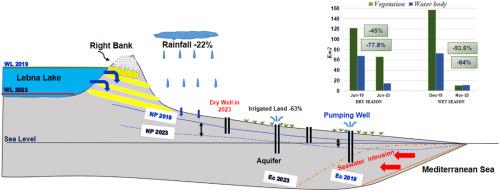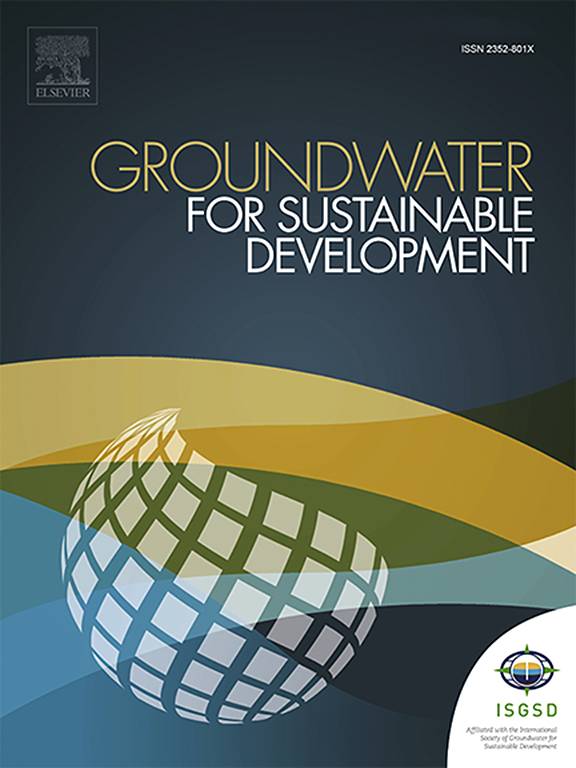长期干旱对缺水地区沿海含水层的影响:以勒布纳(突尼斯东北部邦角)为例
IF 4.9
Q2 ENGINEERING, ENVIRONMENTAL
引用次数: 0
摘要
勒布纳(突尼斯东北部)沿海含水层是支持农业和工业活动的重要水资源。从历史上看,该含水层受益于自然补给和Lebna大坝水库(建于1986年)的投入,这减轻了盐水的入侵。2020年至2023年的严重干旱期严重影响了地下水资源和农业生产力,同时大坝水库接近枯竭。本研究旨在描述这一干旱时期(2020-2023年)的特征,并评估其对沿海地下水资源和农业的影响。采用多学科方法,结合水文地质监测(181口井的地下水水位和盐度)、同位素分析(δ18O、δ2H)、遥感(NDVI、Landsat)、干旱指数(SPI)和实地调查。根据对30名农民的调查,结果表明,与2019年相比,降雨量明显不足(SPI值从- 0.4到- 1.2),灌溉农业用地减少63%。NDVI分析显示,2019 - 2023年,旱季植被覆盖和水体分别减少45%和77.78%,雨季减少93.6%和84%。对2019年和2023年181口井的地下水水位和盐度测量结果进行了对比分析,结果显示,压力计下降了海平面以下9米(mbsl),盐度显著增加,电导率高达21 mS/cm。2019年的大坝填筑提高了地下水位,而在2020年至2023年期间,大坝近乎干涸的状态导致地下水位下降。δ18O和δ2H的同位素分析显示,2019年大坝的地下水补给显著,全球大气水线(GMWL)附近的数值证明了这一点。相比之下,由于水库水位极低(12.85-10.80米),2023年没有发生补给。这些发现强调,迫切需要有效的干旱预测和适应策略来减轻未来的极端事件。本文章由计算机程序翻译,如有差异,请以英文原文为准。

The effect of prolonged drought on a coastal aquifer in water scarcity regions: A case study of Lebna (Cap Bon, Northeast Tunisia)
The coastal aquifer of Lebna (Northeast Tunisia) is a vital water resource supporting agricultural and industrial activities. The aquifer has historically benefitted from natural recharge and inputs from the Lebna dam reservoir (constructed in 1986), which has mitigated saline intrusion. A severe drought period from 2020 to 2023 significantly impacted groundwater resources and agricultural productivity, coinciding with a near depletion of the dam reservoir. This research aims to characterise this drought period (2020–2023) and assess its impact on the coastal groundwater resources and agriculture. A multidisciplinary approach was employed, combining hydrogeological monitoring (Groundwater levels and salinity from 181 wells), isotopic analysis (δ18O, δ2H), remote sensing (NDVI, Landsat), drought indices (SPI), and field surveys. Results indicate a pronounced rainfall deficit (SPI values from −0.4 to −1.2) and a 63 % reduction in irrigated agricultural land compared to 2019, based on surveys of 30 farmers. NDVI analyses showed reductions in vegetation cover and water body of 45 % and 77.78 %, respectively, during the dry season and 93.6 % and 84 % during the wet season from 2019 to 2023. Comparative analysis of groundwater level and salinity measurements from 181 wells in 2019 and 2023 highlighted a piezometric drop of 9 m below sea level (mbsl) and a significant salinity increase, with electrical conductivity reaching up to 21 mS/cm. The dam filling in 2019 raised groundwater levels, while its near-empty state between 2020 and 2023 resulted in lowered groundwater levels. Isotopic analyses of the δ18O and δ2H revealed significant groundwater recharge from the dam in 2019, as evidenced by values near the Global Meteoric Water Line (GMWL). In contrast, no recharge occurred in 2023 due to extremely low reservoir levels (12.85–10.80 m). These findings emphasise the critical need for effective drought anticipation and adaptive strategies to mitigate future extreme events.
求助全文
通过发布文献求助,成功后即可免费获取论文全文。
去求助
来源期刊

Groundwater for Sustainable Development
Social Sciences-Geography, Planning and Development
CiteScore
11.50
自引率
10.20%
发文量
152
期刊介绍:
Groundwater for Sustainable Development is directed to different stakeholders and professionals, including government and non-governmental organizations, international funding agencies, universities, public water institutions, public health and other public/private sector professionals, and other relevant institutions. It is aimed at professionals, academics and students in the fields of disciplines such as: groundwater and its connection to surface hydrology and environment, soil sciences, engineering, ecology, microbiology, atmospheric sciences, analytical chemistry, hydro-engineering, water technology, environmental ethics, economics, public health, policy, as well as social sciences, legal disciplines, or any other area connected with water issues. The objectives of this journal are to facilitate: • The improvement of effective and sustainable management of water resources across the globe. • The improvement of human access to groundwater resources in adequate quantity and good quality. • The meeting of the increasing demand for drinking and irrigation water needed for food security to contribute to a social and economically sound human development. • The creation of a global inter- and multidisciplinary platform and forum to improve our understanding of groundwater resources and to advocate their effective and sustainable management and protection against contamination. • Interdisciplinary information exchange and to stimulate scientific research in the fields of groundwater related sciences and social and health sciences required to achieve the United Nations Millennium Development Goals for sustainable development.
 求助内容:
求助内容: 应助结果提醒方式:
应助结果提醒方式:


